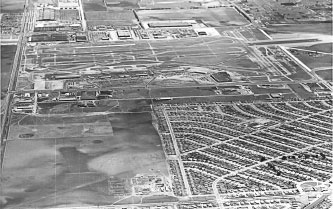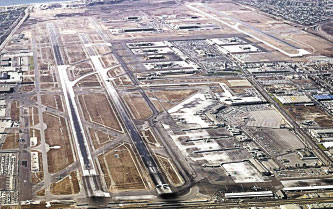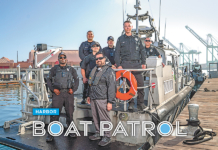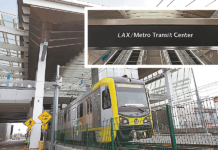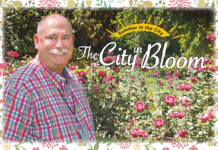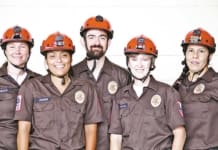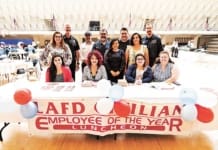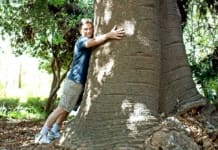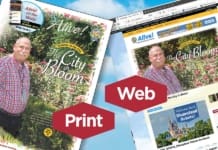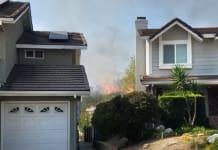Photos by Summy Lam, Club Director of Marketing;
courtesy Ethel Pattison; and as noted
After an astounding 64 years of City service, Ethel Pattison is retiring. Here’s a look back at her amazing career.
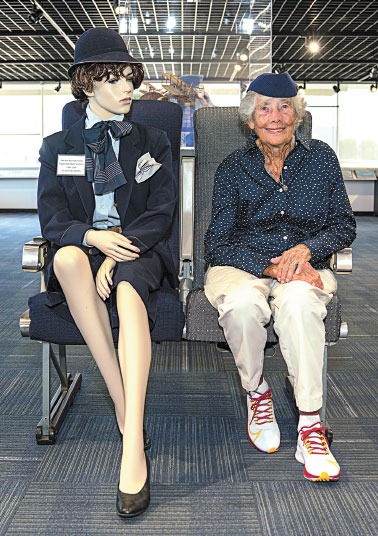
Most Club Members haven’t been, well, alive for 64 years. But that’s how long Ethel Pattison, Airport Information Specialist, has been working for the City of Los Angeles.
After she quit her job as a stewardess for United Airlines – they didn’t allow stewardesses to be married, and she was ready to be just that – Ethel began her career at Airports in January 1956. Her task: to lead tours of the old LAX east of Sepulveda Boulevard to convince school children and adults that LA really needed to expand to empty fields on the west side of Sepulveda nearly to the ocean. The jet age was coming fast – the game-changing Boeing 707 was just about ready for commercial service, and the future was taking off quickly.
LA voters had rejected bond measures twice to expand the airport. Leaders needed a third bond measure to pass. Among their strategies was to hire airport guides to tell the story one on one. Ethel was one of those guides. Some say she was the first such guide, although she’s not sure and there’s no documentation that Alive! could unearth.
Of course she was successful – that third bond issue passed at an 8-to-1 ratio. Her LAX career could have ended there, but in fact it was beginning.
Since then she’s seen an incredible about of change, from propellers to people movers; met presidents, rock stars and actors; help set up the nonprofit Flight Path Museum and Learning Center; and much more.
In this feature, read all about Ethel, now 94, as she represents living history. Thanks, Ethel, for all you’ve done for LAX! Congratulations on retiring from your unparalleled City career, and we’ll see you again soon at the Flight Path Museum.
The Club thanks Tim Ihle, Director of Human Resources, Airports, Club Member, who told us about Ethel’s imminent retirement and helped set up this story; and to Le Valley Pattison, Ethel’s daughter, who provided assistance.

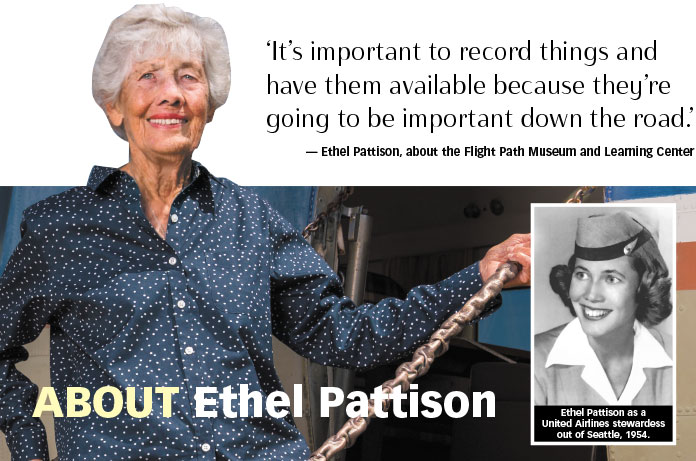
|
Ethel L. Pattison is an Airport Information Specialist for Airports and is set to retire Sept. 26, 2020. She is a 64-year veteran of the department, working in the public and community relations divisions. She began her City career in January 1956. Ethel served for many years as Chief Airport Guide in charge of LAX tours and special events. She was involved in directing student tours, preparing informational materials, responding to media inquiries and assisting the media and public during airport emergencies. Her duties also included assisting civic, business and airport officials in overseas promotions of Los Angeles as a trade and tourism destination. Ethel currently is Historian and Vice President of the nonprofit Flight Path Learning Center and Museum, which was established in 2003 in the LAX Imperial Terminal to preserve Southern California’s aviation heritage and encourage youths to pursue aviation and aerospace education and careers. She directs cataloging and research in the museum’s archives, including historical documents, photographs, uniforms and other memorabilia, dating from 1928 to the present. She also oversees Flight Path’s William A. Schoneberger Research Library. She is co-author of a historical reference book, Los Angeles International Airport, part of the Images of Aviation series from Arcadia Publishing Co.  In recognition of Ethel’s significant contributions to LAX and aviation, the Los Angeles Board of Airport Commissioners named the rose garden adjacent to the airport’s Clifton A. Moore Administration Building in her honor. She was awarded the prestigious Los Angeles City Career Service Award in 1991. Ethel grew up in Hollywood and graduated from John Marshall High School. She holds a Bachelor of science degree from USC, majoring in advertising and minoring in cinema. Following graduation she was advertising manager for Hollyvogue Hosiery and then a flight attendant for United Airlines. A resident of Manhattan Beach, Ethel was married for 53 years to the late Dr. Sydney Pattison, a South Bay dentist. They have a daughter, LeValley, who teaches at El Camino College, and a grandson, Logan. Ethel is past national president of the United Airlines Clipped Wings, an organization of former stewardesses and flight attendants, and was honored with distinguished service awards from the national organization and its Los Angeles chapter. She has been active with the International Special Olympics, the South Bay Vocational Center for the physically challenged, and USC alumni activities. She was awarded a Youth Service Award by the Manhattan Beach Parks and Recreation Dept. |



|
In 1928, the City Council selected 640 acres in the southern part of Westchester as the site of a new airport for the City. Other airports were already in operation, but the City wanted to build in space for future growth. Mines Field, named after William Mines, was dedicated and opened as the official airport of Los Angeles in 1930, and the City purchased it to be a municipal airfield in 1937. The name was officially changed to Los Angeles Airport in 1941, and then to Los Angeles International Airport (LAX) in 1949. The airport’s first iconic building, Hangar No. 1 (now a National Historic Landmark), opened in 1929, and commercial service began in 1946. With the passage of a bond issue on its third attempt, the City expanded LAX westward across Sepulveda Boulevard to the area we now know as LAX. Terminals 2 through 7 were completed and passenger service transferred to the new Jet Age satellite terminals in 1961. The famous Theme Building, which was designated a Los Angeles Historic Cultural Monument by the City Council in 1992, was also completed in 1961. A fourth runway was built later, and Terminal 1, Tom Bradley International Terminal, and the second level roadway were completed in time for LA’s hosting of the 1984 Olympics. An international terminal extension, terminal expansions and a comprehensive people mover and rail connection are now under construction. Before the COVID pandemic froze most commercial aviation activity, LAX was the second busiest airport in the United States and the third busiest in the world behind Atlanta and Beijing.
|

Eyewitness to Progress
On Aug. 28, Club CEO John Hawkins and Alive! editor John Burnes interviewed Ethel Pattison, 94, Airport Information Specialist, Airports, who was scheduled to retire in late September after 64 years of continuous part-time service with the City. Ethel is also considered an LAX historian. She was interviewed with social distancing at the Flight Path Museum and Learning Center (otherwise closed to the public) at LAX, her workplace.
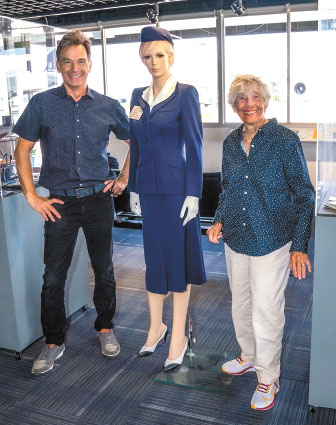
Ethel, thank you so much for agreeing to talk to us today. You’ve been in quarantine at home since March, but agreed to come back here to the Flight Path to be interviewed.
Ethel: Glad to do it! Yes, the Flight Path has been closed due to the emergency, and we’re using this time to upgrade it. I’m an Airport Information Specialist and historian with Airports, and a board member and one of the founders of the Flight Path Museum.
Got it. Had you been collecting a lot of things before they created a museum?
Ethel: I gathered a lot under my desk in the old control tower administration building, and then it sort of led to this building, which was vacant. The department said, “Why don’t we make it a museum?”
What’s your favorite thing that you collected? Your uniform from when you flew for United?
Ethel: Well, I certainly cherish that.
That must have been a really exciting time in your life.
Ethel: Well, it was short, though.
Right. We’ll get to that in a minute. So, 64 years of service! And you’re 94 – is that okay to tell people that?
Ethel: Yes. I never would believe I’d ever be that.
You’re finally going to retire in September, a few weeks from now.
Ethel: Well, that doesn’t mean I’ll be gone. I’ll be here at the Flight Path Museum a lot as a volunteer.
After 64 years, why have you decided to retire?
Ethel: I don’t know. I’m saving them some money, even though I’m not very expensive!
I’m not trying to break any records. I don’t know if there are any records.
Well, we’ve been doing this newspaper, and now Website, for 18 years. We’ve met no one who has anywhere near 64 years of service. That is incredible.
Ethel: I was hired part-time to give tours to all kinds of groups, including adults to pass the bond issue in 1956.
Yes, that’s important. We’ll talk about that in a minute.
Ethel: Sure.
 Taking Flight
Taking Flight
Let’s go back. Before your City career, you were a flight attendant for United. Do you prefer the term flight attendant or stewardess?
Ethel: We used “stewardess” at the time. I’m fine with that. TWA used the word “hostess,” and others used the words “flight attendant.” Now, since men are involved – which they were then for Pan Am as couriers at the time, they use flight attendant. But that’s not really the way it was conceived, which was for women. We liked “stewardess.”
You’re from Los Angeles?
Ethel: From Los Angeles. I grew up near Griffith Park, went to John Marshall High School, and then went to USC to get my degree during World War II.
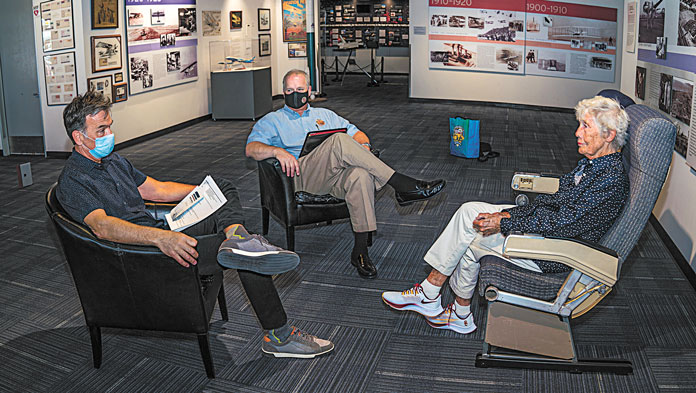
What did you do after you graduated?
Ethel: I worked for a hosiery company in advertising. The Hollyvogue Hosiery Co., at 37th and Broadway, for a year or so.
Were you ever supposed to go into medical like your dad?
Ethel: No. And my brother didn’t, either. He became a civil engineer.
How did you come to work for United?
Ethel: I had a sorority sister at USC who worked for United. She’d come to the sorority house on Monday night when all the former sorority members would come and see friends. She’d come in her uniform and somehow I got the bug. I applied, and then I was sent to Seattle to be based out of there. She got to stay in LA, and I was way up there where it rained all the time. But I met some great friends.
Sure. Did you fly back here very often?
Ethel: Every so often. The planes used pistons – propellers – so you couldn’t go nearly as far as a jet. I went to Denver and San Francisco, and sometimes as far as Chicago.
What airplanes did you fly?
Ethel: DC-4s and DC-6s, 6Bs, not 7s – I didn’t work there that long.
I started on a DC-4 that has round windows and propellers. A DC-3 went shorter routes because it didn’t handle so many people and flew at 180 miles an hour. DC-4s flew at 230. I didn’t work on any jets.
How long did you fly?
Ethel: I flew for only about 15 months. I met my husband in Cheyenne, where United trained us. I met him in church of all places, the First Presbyterian Church of Cheyenne.
Did he work for United?
Ethel: No. He became a dentist out of the University of Nebraska.
When you trained in Cheyenne, was that the first time you left California?
Ethel: I’d say so.
Why did you leave United?
Ethel: Because we were going to get married, and you couldn’t be married and be a stewardess. That was the rule.
Wow. Did you just accept that?
Ethel: Well, that’s the way it was, yes. We accepted that.
You told me earlier there were some stewardesses who set up ways to get around that rule.
Ethel: That’s correct. Some were married but had two telephone lines. If you called them for a flight, she’d have them call the line that was only hers. It’s mind-boggling today – everyone has their phone. You can’t imagine it, but that’s what some stewardesses had to do.
So I left because I was going to get married.
You moved back home, to Los Angeles.
Ethel: Yes. It was okay with him, and I wasn’t going to live in Nebraska. I’m not used to the weather. It’s a shock!
Landing at LAX
Let’s set the place. When you began at LAX in 1956, what was the airport like? We all have a sense of this big airport here, but tell us where it was and what it was.
Ethel: It was on Century Boulevard, east of Sepulveda. Nothing was here [west of Sepulveda] except an old terminal. This is on Imperial and the airport, as everyone knows it today, is located west of Sepulveda and north of Century.
Did the City own this land when you started here?
Ethel: Yes.
It was obvious that they had to expand the airport onto this new land.
Ethel: Yes. Very much. We built the new passenger terminals in 1961, dedicated by Lyndon Johnson, Vice President at the time.
In 1956, you were hired as an Information Guide.
Ethel: Well, a tour guide. We gave tours. The intent was to pass the bond issue in 1956 to build the new terminals as you know them today, west of Sepulveda. They wanted to expand what was already in place on the east side of Sepulveda on Century.
The City saw that it was going to need more space, and the jet age was coming. Both of those things were coming together, and the City decided it needed to expand.
Ethel: Good job, yes!
The City had floated a couple of bond issues to finance the expansion, but both of them failed.
Ethel: Right. They did not pass, so they wanted a different strategy get the third one passed. It was a bond issue for $59 million, and it passed eight to one.
What made the difference?
Ethel: Well, teaching the public. We did a lot of tours for school children, where we talked about expansion. They would go home and tell their parents what we needed and why. The education of voting public is what changed.
Were you the first airport guide hired in the City?
Ethel: I don’t remember. There were eight of us. Two or three retired after 40 years. They were great because you didn’t have to train them, and they knew how to handle people and did many other jobs for public relations, which, as you might imagine, are very important.

Is there anything left of the old airport on Century other than the historical Hangar 1 that was here when you started?
Ethel: A few little cargo buildings here and there, but nothing dominant.
Do you remember where your first office was?
Ethel: Yes. It’s a cargo building on 5800 W. Century Blvd. It was a two-level building, and there was a coffee shop over there. It was next to a post office.
It’s hard for people to understand how much things have changed. The City was really growing fast at that time.
Ethel: Yes. Like I tell my daughter, it’s important to record things and have them available because they’re going to be important down the road. People just take things for granted now.
Do you remember what your salary was in 1956?
Ethel: Not very much. I worked part-time. [$1.50 an hour. – Ed.] I thought I made quite a bit of money!
How many tours did you take a day?
Ethel: Three. Second-graders and up, or adults, service clubs … it just depended.
Did you enjoy what you were doing?
Ethel: Oh, yes. We had about eight girls who were all former flight attendants, hostesses and stewardesses. We provided a uniform look and wear a uniform for a couple of years so that we could find each other in the terminal buildings moving from the old Century terminal to the new terminal in 1961.
And now, you’re moving into yet another new era, with the terminal connectors, the Tom Bradley west extension, the people mover and the remote facilities. The growth you’ve seen is unbelievable.
Ethel: On the same footprint. I think it’s remarkable that we managed to change that footprint to add more passengers and ways to drop off, pick up, and just get here.
What was it like to work here at LAX before there were jets?
Ethel: That was pretty much a long time ago now.
Yeah. Was it just a little slower or noisier?
Ethel: Noisier, probably, but it can be pretty noisy.
History, and Famous People
You’re a historian. You tell the story of the airport. What do you want people to know about the airport?
Ethel: Most people can’t imagine it started as a little dirt strip way out of town. There were 57 such runways around the City that were considered for development because the City leaders said, “Well, we’ve got to have an airport somewhere.” There was Burbank, Glendale Airport at the time. They had to make something that would have enough room to expand. Landings and takeoffs generally come into the wind or over the ocean and over the City coming west. The jets really became noisy, although the props were noisy too, but that wasn’t a big issue then.
When you started, could they fly non-stops to New York City?
Ethel: No. They had to stop somewhere. Denver, generally speaking.
Could the City have grown as fast as it did without an airport growing too? How important was the airport to the growth of LA?
Ethel: It took the place of the train, more or less. The train was the provider before that. There was just a huge demand for faster travel.
Talk about meeting some famous people here.
Ethel: Well, there was Khrushchev.
The Soviet Premier, Nikita Khrushchev. He came in 1959. I think that was the first time a Soviet Premier had set foot in the U.S.
Ethel: So they set up a big stage for him to wave when he got off the plane. It was a press-only event. They introduced him, and I started clapping. I didn’t realize the press never claps! I was the only one clapping. I was embarrassed.
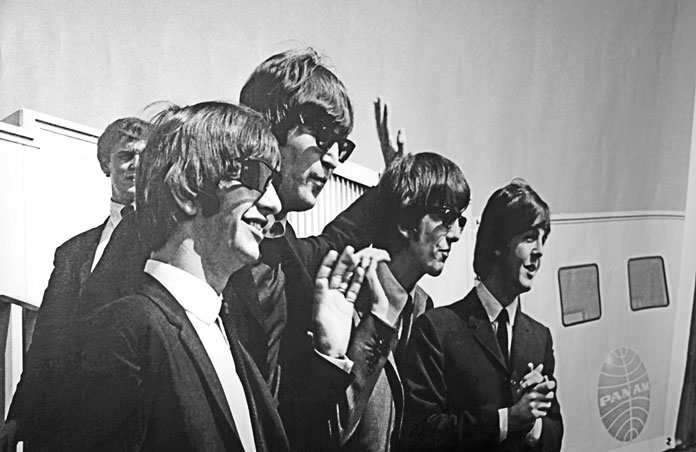

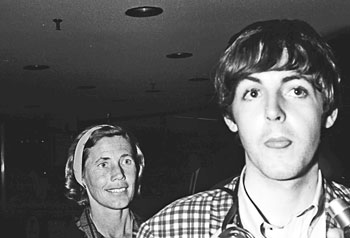
I know you got to meet the Beatles.
Ethel: Right. One of our girls in the public relations office, Angie Macias, had met them in Amsterdam [possibly Copenhagen – Ed.] when they were on tour. She said, “What’s the commotion at this hotel?” “Well, The Beatles are here.” But they weren’t famous yet, there or here.
Right. So she knew about them.
Ethel: Angie was the pretty young, attractive vacation girl type, and they actually just went up to the top floor in an atrium area. They were sitting there. She told them that we at LAX were preparing for their visit. “We’re in public relations and we know you’re coming.” Well, she became the go-between between LAX and their cranky manager, Brian Epstein. They stayed in a private residence in Bel Air, and then they had a whole private house the next time they came.
One night, we were getting ready for them, and I’m driving in a Metro bus down Imperial, acting as a decoy. “Well, this is a heck of a job,” I told myself. “I’m riding all by myself on this bus and we are a decoy.”
Did it work?
Ethel: I guess it worked. I don’t know. It took all of those things maneuvers because teenage girls knew exactly where they were at all times.
That was a fun time.
Ethel: Yes. It was.
You met them. You’re a photographer, and you took pictures of them.
Ethel: I did.
Any other celebrities?

Ethel: Well, Liz Taylor and Richard Burton. I said to someone, “Aren’t they pretty good?” “Oh, not like The Beatles,” someone said. But I took my own pictures and they’re pretty good, of them on a propeller and on the stairs for the boarding. But that was not newsworthy like the Beatles.
You’re a very good photographer. You took well-known pictures of the Beatles, Liz and Dick, and Richard Nixon. You’ve met a lot of presidents.
Ethel: Yes.
How did you handle celebrities, to keep them out of terminals?
Ethel: We would do the best we could and escort their vehicle to the airplane in those days. Most of them would get off and come down the stairs. You could just exit the plane door and go down the stairs and meet your vehicle on the ramp. We would do that rather than go through the terminal.
If you get involved in public relations, you get involved in everything and then that’s fun. Certainly you never know what’s going to be next and who might walk in. It’s still that way.
Who was your favorite mayor?
Ethel: Tom Bradley was the mayor a long time and was involved in the opening of the terminals in ’61. He was around a lot and friendly. Back in the day he could walk in and out easily. He was good for us and good for the airports. And his wife’s name was Ethel!
Who were some of your favorite people to work with?

Ethel: Too many to remember, but a few come to mind. The key one for the airport was Peggy Hereford, the airport Public Relations Manager from the 1950s to the ’70s. The Airport Managers at the time, Francis T. Fox and Cliff Moore, often called her up to the top floor of the tower to ask her how the press would react to a decision or policy they were discussing. It was amazing the respect that she earned and the esteem that she held. She was so influential to me.
We had some talented PR managers who followed Peggy Hereford: Virginia Black, who went to USC and was a sorority sister of mine; and Lee Nichols was a fantastic PR director. They hired Nancy Niles as the Community Relations Director, and she was pretty fantastic, too. All of them could handle the community and their job. You had to know how to write. We didn’t have spellcheck, and some of us were terrible.
Speaking of celebrities – the Concorde might have been the most famous plane to fly into LAX. It flew here on a sales mission, before it ever started commercial service. Do you remember the first time you saw it?
Ethel: Yes, it was little.
You weren’t too impressed!
Ethel: Not really. We went inside, and it was little. It held, what, 70 people? That’s all. Not very many people!
It was a big day, though, and certainly it was sad that it never made it commercially out here, but then time goes on.
The Past and Future of LAX
What was your biggest challenge in your career?
Ethel: Probably when the Beatles visited.
Do you remember when they had a housing development at the end of the roads? I think it was called Surfridge.
Ethel: In Playa del Rey.
Right. It was like 800 homes and 2,000 residents. Now it’s abandoned. Was that a big PR issue?
Ethel: Well, they hated to move, but it was noisy. We moved them to designated areas or wherever they bought and then helped them make the move.
Airports was responsible for finding them a new location.
Ethel: Yes. Noise was the issue.
If you had to name your top three toughest things to work with, what would they be?
Ethel: Accidents, celebrities coming and going, and growth of the airport.
Accidents?
Ethel: They happened twice, one week apart, two Saturdays. One was right out our window on the north side. A guy flew in from the west and overran and he couldn’t stop in time.
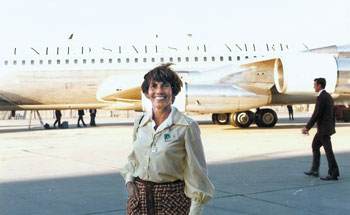
Those had to be the most stressful times.
Ethel: Yes, but there weren’t too many.
What was it like to work here on 9-11?
Ethel: There was nobody at the buildings, and no cars on the road going in. That’s pretty different.
PR was just really busy. We had to go to PR to find out what was going on. We didn’t have our own phone.
Was it an emotional day?
Ethel: I’m sure it was. It’s hard to remember that part.
Do you have a favorite airport? Or a least favorite?
Ethel: I can look at an airport and say what’s wrong right off the bat, like too big, too far to walk, no moving sidewalk. We didn’t have a moving sidewalk until way into my time here, and it was a long way to walk.
Did you do any work at Ontario when the City owned it?
Ethel: We went to the dedication of Ontario when we owned it. We worked the day but not ever again.
Did you think that Palmdale was ever going to grow?
Ethel: We thought so. Everybody seemed to think everybody’s going to move to the desert. Everybody thought we’ll put an airport there because all these people were going there. Well, they didn’t go, or they could get better and cheaper service here so it didn’t pay.
Are you going to take a ride on the new people mover when it opens?
Ethel: I don’t know. I think I should.
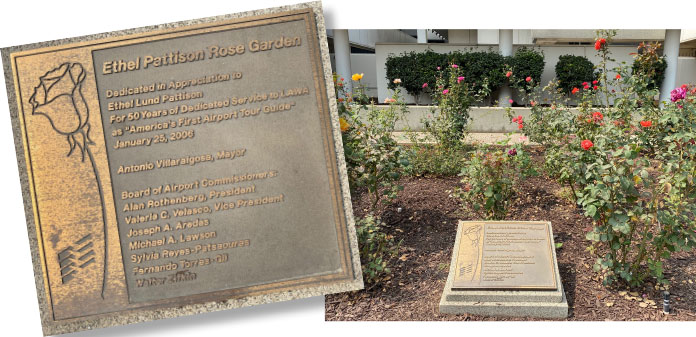
I think you should. In fact, I think you should get a whole car named for you. Speaking of which, LAX has a rose garden named for you.
Ethel: Yes, it’s front of the old tower, to the east of the Theme Building. It’s near where people used to walk from the terminals to the hotels.
Your daughter tells us that only five things at LAX have been named for people. And the rose garden is one of them.
Ethel: Maybe so.
That says about all that needs to be said for what you mean to LAX. Ethel, thank you so much for talking to us today. Our readers, and really all the City, really appreciate it.
Ethel: You’re welcome.





